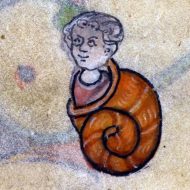Sir Thomas Wyatt, Songes and Sonettes
Born in 1503, Sir Thomas Wyatt is an English Renaissance poet who is famous for his diplomatic career and his controversial private life. In his early years, he received his education in St. John’s College, Cambridge. His courtly life began in 1526 when he travelled to France and Italy for diplomatic affairs. Arguably, in his travel to Italy, Wyatt may have been impressed by Petrarch because Wyatt’s early contribution to English literature traces back to his adaptations of Petrarch’s sonnets. Petrarchan conceit’s influence on Sir Thomas Wyatt is worth considering because it gives readers an opportunity to speculate about the nature of his troubled love affairs. In Sir Wyatt’s adaptation of Petrarch’s “Rima 190” which is “Whoso list to hunt”, Wyatt creates a metaphor for unrequited love based on the practice of hunting. Some literary critics argue that Sir Wyatt addresses to Anne Boleyn in most of his love sonnets because among Wyatt’s romantic relationships with women, his relationship with Anne Boleyn, Queen of England was the most controversial one. Although it is not known whether there was a passionate or a platonic love between Sir Thomas Wyatt and Anne Boleyn, Wyatt was imprisoned for his suspected secret affair with King Henry VIII’s wife, Anne Boleyn. In 1536, Anne was executed to death on adultery charges but Wyatt was freed. After his release, Wyatt was appointed as Henry VIII’s ambassador to Spain in 1537. After returning back to England in 1539, Wyatt developed a friendship with Henry Howard, Earl of Surrey. Both of their love of Italian sonnets is probably the keystone of their companionship. In 1542, Sir Thomas Wyatt died from a serious fever, at the age of 39.

In his lifetime, not any sonnet of Wyatt was published, however, after his death his poetry was published in Henry Howard’s Songes and Sonettes otherwise known as Tottel’s Miscellany in 1557. Interestingly, Wyatt’s name does not appear in the frontispiece of Songes and Sonettes whereas Henry Howard’s name appears. Considering the hierarchical order of English aristocracy in 1500s, someone who had the title of Earl in their name was regarded as superior to someone who had the title of Sir. Because of this reason, Henry Howard, Earl of Surrey’s name and his portrait appear in the frontispiece, though his contribution to Songes and Sonettes is less than Sir Thomas Wyatt’s contribution in terms of the number of the poems.

The font style of Songes and Sonettes is Black Letter which the contemporary readers may find it illegible as they are not familiar with it. Although the Black Letter font style may be a little bit illegible, it looks fancy enough to catch readers’ attention. Besides the intriguing font style, the content of the dedication page is interesting enough to focus on too. In the dedication page, Richard Tottel who is the first publisher of Songes and Sonettes addresses to the reader: “And I exhort the unlearned, by reading to be more skilful, and to purge that swinelike grossenesse.” Tottel’s claim about the sonnets not only encourages readers to appreciate reading it, but it also encourages them to abandon their ignorance. While dedicating to the readers, Tottel’s choice of a highly rude language may not satisfy the expectations of the reader. However, it is quite likely that Tottel may have aimed to prevent the possible prejudices against a new kind of English sonnet form with his bold claims.
Begum
Works Cited
Surrey, Henry Howard, Earl of. Songes and Sonettes, Written by the Right Honorable Lorde
Henry Howard Late Earle of Surrey, and Other. London, 1557. Early English Books Online. 4 December 2019. https://eebo.chadwyck.com/search/fulltext?SOURCE=config.cfg&ACTION=ByID&ID=D00000998421230000&WARN=N&SIZE=479&FILE=&ECCO=undefined
“Wyatt, Thomas, Sir, 1503?-1542.” Literature Online,
https://search.proquest.com/lion/docview/2137933847
